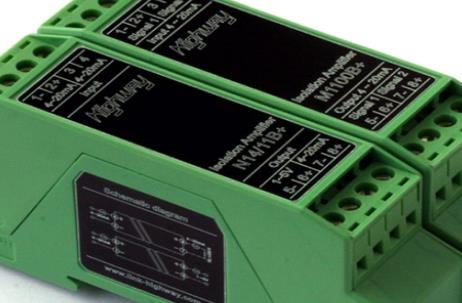Analog isolator is an electronic component used to isolate analog signals between two circuits to prevent interference between circuits. It usually consists of two analog signal converters, which can convert analog signals into digital signals and then convert them back into analog signals to achieve isolation.
Signal isolator is a kind of linear optocoupler isolation principle, which converts input signals into output. The input, output and working power supply are isolated from each other, which is particularly suitable for use with equipment and instruments that require electrical isolation. Signal isolator , also known as signal isolator , is an important component in industrial control
systems. Signal isolator has many uses and its functions are also very powerful.
Signal isolator function:
1. Protect the control loop of the lower level .
2. Weaken the influence of environmental noise on the test circuit.
3. Suppress the interference of common ground, frequency converter , solenoid valve and unknown pulses on the equipment; at the same time, it has the function of limiting voltage and rated current for the lower level equipment, which is the faithful protection of transmitter, instrument, frequency converter, solenoid valve PLC / DCS input and output and communication interface.
The functions of the signal isolator give it great advantages in terms of isolation capability, anti-electromagnetic interference, etc. At the same time, the signal isolator is flexible in application, and it also has functions such as signal conversion, signal distribution and interface conversion, making it more convenient to use.
The signal isolator converts the input single-channel or dual-channel current or voltage signal into an isolated single-channel or dual-channel linear current or voltage signal, and improves the electrical isolation performance between the input, output, and power supply. The working principle of
the signal isolator is to first modulate and transform the signal of the transmitter or instrument through a semiconductor device, then isolate and convert it through a photosensitive or magnetic inductive device, and then demodulate and transform it back to the original signal before isolation, and isolate the power supply of the isolated signal at the same time. Ensure that the converted signal, power supply, and ground are independent. What are the functions of
analog isolators ?
The disadvantages are: 1. High cost; 2. High power consumption; 3. High noise; 4. Limited signal transmission distance. The selection of
analog isolators mainly considers the following aspects:
1. Signal type: Analog isolators can support a variety of signal types, such as analog signals, digital signals, analog/digital signals, etc.;
2. Signal range: The signal range of the analog isolator should be selected according to the actual application needs;
3. Signal transmission distance: The signal transmission distance of the analog isolator should be selected according to the actual application needs;
4. Power consumption: The power consumption of the analog isolator should be selected according to the actual application needs;
5. Noise: The noise of the analog isolator should be selected according to the actual application needs.
productsmenu
cindy@justwellcenter.com+86 13376981664
You are here:
- Home
- Industry News
- How to choose a signal…







